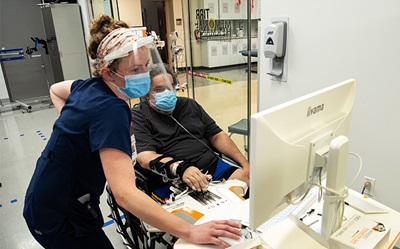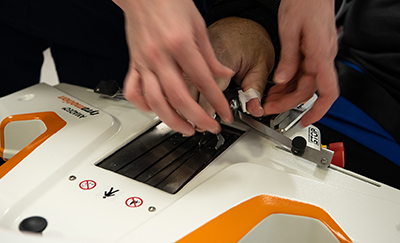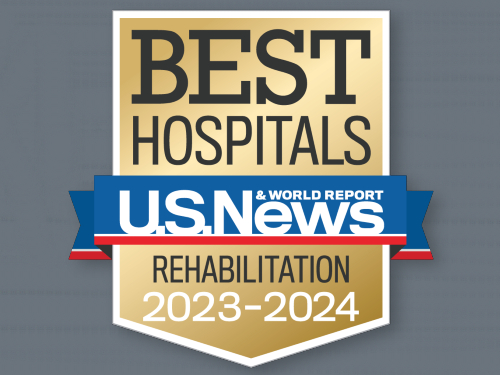
Emergency medicine physician Grant Lashley, MD, is among the many healthcare professionals who contracted COVID-19 while treating patients during the United States’ first wave of virus cases in April 2020. While working the night shift in the emergency department at Abbeville General Hospital in Louisiana, he diagnosed one patient with COVID-19 and intubated another. A few days later, the 50-year-old noticed mild symptoms.
“We were careful with our use of personal protective equipment, because even then we knew there were asymptomatic carriers,” Dr. Lashley says. “For about four days, in the evening around 7 p.m., I remember telling my wife that I didn’t feel good. I had no fever or shortness of breath. We were headed into what I knew would be a busy weekend in the ER, and I thought I might have the flu. The results of my tests came back positive for strep and COVID-19. It seemed like a mild case and I thought I would recover at home, but my oxygen saturation levels kept dropping.”
Twenty-four hours after testing positive for the virus, he was admitted to the COVID-19 Unit at Lafayette General Medical Center. After another 24 hours, he was transferred to the ICU and intubated, according to his wife Melisa Harrington, MD, a nephrology specialist in Lafayette. Dr. Lashley has almost no memory of his time in intensive care, where he remained intubated for 37 days. His wife later told him he suffered a stroke and underwent dialysis twice, while receiving every treatment recommended at the time for COVID-19.
On Mother’s Day, his care team talked with Dr. Harrington about removing her husband from life support. “She said no, and she and my critical care specialists decided to try a high dose of steroids, which became the standard of care for severe COVID-19 cases about a month later. I think that’s what turned me around,” Dr. Lashley says.
When he regained consciousness, he didn’t realize he had lost more than a month of life. The long ICU stay left Dr. Lashley with a right wrist drop and left foot drop as a result of critical illness polyneuropathy. He also had generalized weakness after being immobilized on a ventilator for 37 days. He had lost nearly 40 pounds, almost half of which was muscle mass. After two weeks at a local long-term acute care facility, at the end of May 2020, he was transferred to TIRR Memorial Hermann under the care of physiatrist Nikola Dragojlovic, DO, an assistant professor of physical medicine and rehabilitation at McGovern Medical School at UTHealth who specializes in the management of patients following traumatic brain injury, polytrauma, stroke and other neurologic disorders.
“We designed a physical therapy program geared at improving strength of the proximal muscles in Dr. Lashley’s arms and legs to do the heavy lifting of his body required to sit up and transfer out of a chair, go to the bathroom and eventually go back to daily life,” Dr. Dragojlovic says. “His occupational therapy program was aimed at recovering dexterity in his hands. His speech therapist helped him with breath-support protocols that included special breathing techniques that allow people recovering from COVID-19 to regain the endurance they lost due to poor efficiency of the lungs. By learning the protocols, he regained the use of his lungs, his voice improved, and he could maintain his breath during physical activity.”

Dr. Lashley says his experience at TIRR Memorial Hermann was amazing. “I had heard good reports about TIRR but didn’t know what to expect. I found that everyone on the team was supportive, positive, and motivational – from nurses to physical therapists and occupational therapists to speech therapists to the folks in dietary.”
“Kathy Gordon, my physical therapist, was fantastic. When I said I couldn’t do something, she said, ‘Yes you can.’ And I did,” he says. “My occupational therapist was Megan Cleveland. Her spirit was unsurpassable. She had the kind of energy a patient needs to see. She finds your weak spots and helps you improve. All the therapists I encountered were really great.”
“Early on I recognized my limitations,” Dr. Lashley says. “When this happens, you can either get depressed or do something about it. As an ER doctor, I’m used to living fast. I’ve never functioned in life in a slow, steady manner. I had to take a step back and learn to view every small improvement as a big deal. By the time I left TIRR, I was able to walk around the gym with a walker, which I never would have imagined. I’m very aware that I’m still near the beginning of my real recovery but I no longer need to be in an institution because of what TIRR did for me.
“There’s more that can happen with COVID-19 than just very bad pneumonia. You can have a stroke and develop blood clots. Those of us who have the good fortune to survive the effects of the virus can get better, and TIRR is a great place for that. One thing that happens is that the people you work with become a lot like family, and at the end, it becomes emotional to leave. In medicine, things can become very sterile, and that’s definitely not the case at TIRR.”

Nationally Ranked Rehabilitation
For the 34th consecutive year, TIRR Memorial Hermann is recognized as the best rehabilitation hospital in Texas and No. 4 in the nation according to U.S. News and World Report's "Best Rehabilitation Hospitals" in America.
Learn MoreContact Us
If you have questions or are looking for more information, please complete the form below and we will contact you.